
Which animals could benefit from a crossing designed by you and your team?
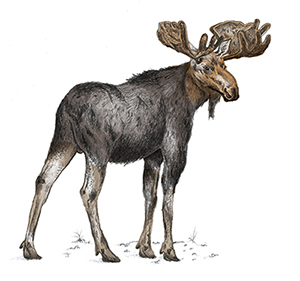 Moose
MoosePhoto from MEIFW site
While Maine is home to the highest moose population in the lower 48 states, they are often hit as they cross roads. When this happens, serious injuries or death often happens to the people in the vehicles, along with injury or death for the moose. Moose also require salt in their diets. While this can be provided by some plants, moose are often found on roads or roadsides, where they can lick the salt put down by plow trucks to melt ice, making them more likely to be hit. A road crossing for moose would save animal and human lives.
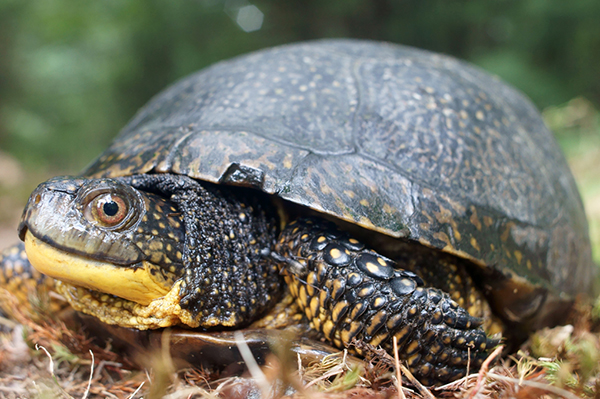
Photo from MEIFW site
Blanding's turtles are endangered in our state, and relatively rare, found only in Southern Maine. They must travel between vernal pools, marshes, swamps, streams, and ponds, and also to the woods. They spend part of the summer under leaf litter in the woods. Sometimes they travel up to 1.2 miles between different wetlands where they feed on breeding amphibians like frogs and salamanders, so their habitat is fragmented by roads where they can be killed.
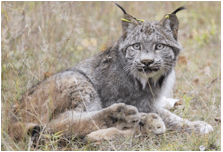
Photo: Dorothy Fescke from MEIFW site
Canada lynx are listed as "threatened" by the United States, and Maine is the only state in the Northeast where the lynx live and breed, though Montana, Washington, Minnesota & Colorado have breeding populations as well. Lynx travel across large ranges to breed and hunt snowshoe hare, their main food source. Their habitat is divided by roads, where lynx can be hit by vehicles and killed.
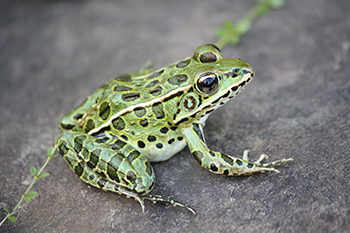 Northern Leopard Frogs
Northern Leopard FrogsPhoto: Trevor Persons from MEIFW site
Northern Leopard Frogs are a threatened species in Maine because their habitats are divided by roads. They need to cross over to get from their winter hibernation locations to the water sources where they lay their eggs. Each spring when the snow has melted and there is a rainy night to provide the necessary moisture for their skin, these frogs come out and cross the roads in the dark. As amphibians, the chemicals found on roads are easily absorbed through their skin and are toxic to the animals. While volunteers help them across the roads during those spring nights as much as possible, many are still killed by cars.
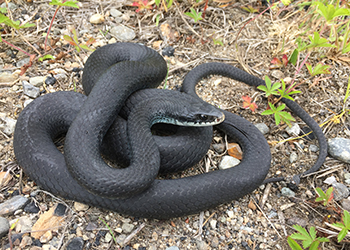 North American Racer, or Black Racer
North American Racer, or Black RacerPhoto: Trevor Persons from MEIFW site
Black racers are endangered in the state of Maine, and only live in Southern Maine. They have a large range (they travel far, about 1.5 miles), and they like to return to the same burrows every year for the winter. They like to use electrical corridors (paths for power lines) with lots of shrubs when they travel. They eat a variety of animals including small mammals; frogs; nestling birds; and insects, especially grasshoppers. Predators of the black racers include birds of prey, like hawks and eagles. Their habitats have been broken up by roads and farmland, limiting their ability to travel for breeding or to establish new nesting grounds. A road crossing for black racers could help them navigate their entire habitat safely.
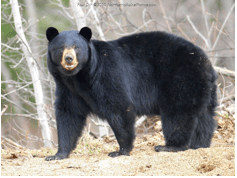 Black Bears
Black Bears
Photo: Paul Cyr from MEIFW site
Black bears' habitats are divided by roads. They average 250-600 pounds, and they need forests for protection and food. Most of their deaths are due to human-related causes; they can survive up to 30 years in the wild. Male bears travel within large areas of 100 square miles, and sometimes travel even farther from their homes to find their own territories once they reach 1-4 years old. Females usually stay within the same 6-9 square miles, except when they are getting reading to hibernate in the late summer or fall. At this time, they can travel as far as 40 miles away from their usual range in search of berries or nuts. This means bears often have to cross roads, where they can be struck and killed, often causing injury or death to the people in the vehicles as well.